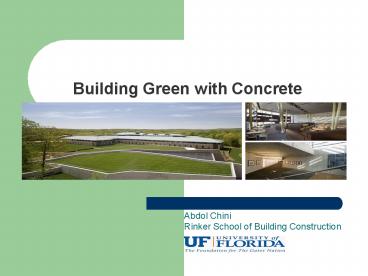Building Green with Concrete - PowerPoint PPT Presentation
1 / 12
Title:
Building Green with Concrete
Description:
Storm water management (pervious concrete) ... durable, light in color, can be pervious, and does not pollute its final environments. ... Pervious Surfaces ... – PowerPoint PPT presentation
Number of Views:3158
Avg rating:3.0/5.0
Title: Building Green with Concrete
1
Building Green with Concrete
Abdol Chini Rinker School of Building
Construction
2
Impact of buildings on our natural environment
- In the U.S. alone, buildings account for
70 of electricity consumption, 39 of
energy use, 39 of all carbon dioxide
emissions, 40 of raw materials use,
30 of waste output (136 MT annually), - 12 of potable water consumption.
3
Green Building
- Green building is the practice of increasing the
efficiency with which buildings use resources
energy, water, and materials while reducing
building impacts on human health and the
environment during the building's lifecycle,
through better siting, design, construction,
operation, maintenance, and removal.
4
Ready-Mix Concrete Manufacturing
(www.ibisworld.com)
5
MAJOR MARKET SEGMENTS (www.ibisworld.com)
6
Sustainable Concrete
- Five ways concrete helps building green
- Concrete creates sustainable sites
- Storm water management (pervious concrete)
- Reduce heat islands (reflectance of 0.35 to 0.5
compared to 0.05 to 0.15 for asphalt) - Concrete enhances energy performance
- Heat storage capacity (thermal mass)
- Concrete contains recycled materials
- Supplementary cementitious materials (fly ash,
silica fume, and slag) - Concrete is manufactured locally (reduced
transportation) - Concrete builds durable structures
7
Horizontal Construction
- Concrete is durable, light in color, can be
pervious, and does not pollute its final
environments. - Research in this cluster will focus on
- initial vs. life cycle costs
- heat island effects
- facilitating navigation among populations with
limited visual acuity - the development of LEED criteria for Portland
Cement Concrete Pavements
8
Pervious Surfaces
- Water infiltrated through paved surfaces rather
than captured in stormwater basins minimizes the
use of retention ponds and reduces pollutant
loads. - Potential studies
- measure runoff quantity and quality from pervious
concrete or semi-pervious paver systems and
compare their performances with asphalt paving
and other surfaces.
9
Embodied energy for one m3 of a 28 MPa
compressive strength concrete
10
Solar reflectance and Solar Reflective Index
(SRI) of select material surfaces
11
CO2 Absorption
- The carbonation of concrete is a chemical process
where atmospheric CO2 reacts with CaO in the
concrete to form calcium carbonate (CaCO3). - The carbonation process is relatively slow
process and depends on the diffusion rate of CO2
into the concrete. - A Canadian company named Carbon Sense Solutions
based in Halifax claims that it has found a
technique to accelerate precast concrete curing
using CO2 within the combustion flue gases.
12
Summary
- Embodied energy and CO2 emission of concrete can
be reduced by using industrial by-products with
cementitious and/or pozzolanic properties. - Use of concretes durability and thermal
efficiency, and application of pervious concrete
in stormwater management are becoming more
commonplace. - A technique to accelerate precast concrete curing
using CO2 within the combustion flue gases is
promising































